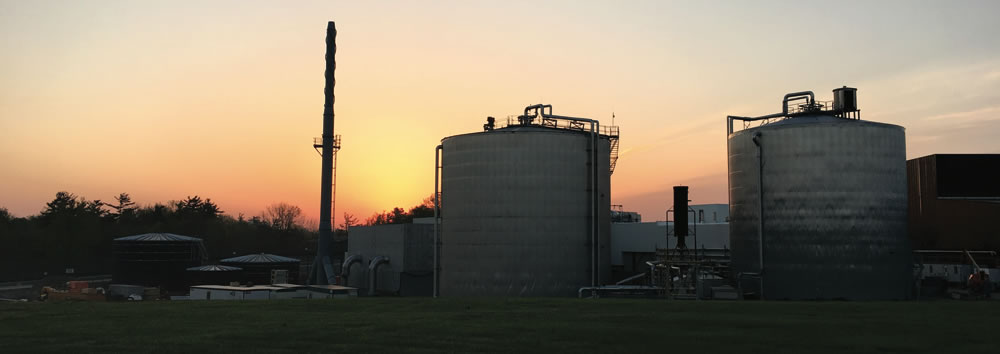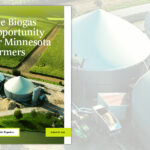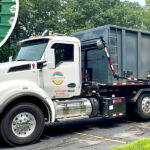Biogas produced from anaerobic digestion of residential organics is on track to be upgraded to renewable natural gas via partnership with gas utility.
Peter Gorrie
BioCycle March/April 2019
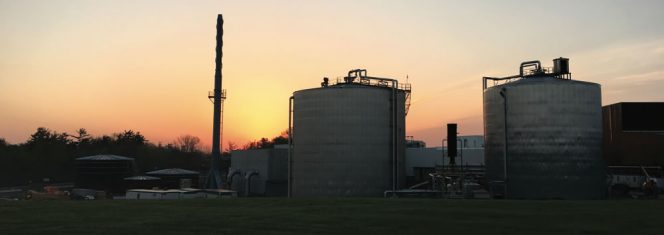
The City of Toronto’s Dufferin anaerobic digestion facility generates over 5 million cubic meters/year of biogas and is scheduled to begin injecting RNG into the Enbridge pipeline by early 2020. Photo courtesy City of Toronto
The City of Toronto, Ontario has begun installing the first of what could be four facilities to produce large quantities of renewable natural gas (RNG) from the collection and processing of residential source separated organics (SSO) and solid waste. The initial project will upgrade the more than 5 million cubic meters of biogas produced annually through anaerobic digestion of residential SSO at the recently expanded Dufferin Organics Processing Facility. Installation began in February 2019 and the first gas molecules are expected to flow by the end of this year or early in 2020.
Under consideration are three additional facilities. One would be installed to upgrade biogas from Toronto’s second and larger anaerobic digestion facility at a site known as Disco Road. The other two would upgrade landfill gas at solid waste sites — the active Green Lane Landfill, about two hours southwest of Toronto, and the Keele Valley Landfill, just north of the city, which was closed 20 years ago.
The four sites “have the potential to make Toronto the largest producer of RNG from biogas and landfill gas in Ontario,” notes Carlyle Khan, director of infrastructure development and asset management for the City’s Solid Waste Management Services. “Over the last few years, the City has been looking for opportunities to harness the green energy potential of these gases (which are now flared) and identified RNG as a top priority for the Solid Waste division.”
The RNG project stems from recognition that climate change is a real issue and municipalities can make the single most significant impact in reducing greenhouse gas (GHG) emissions,” explains Khan. “Our approach complements the City’s decision to purchase Class 7 and 8 collection trucks fuelled by compressed natural gas (CNG) as its diesel fleet reaches the end of its service life, usually five to seven years.”
The CNG-fuelled fleet now totals 115 vehicles, with another 19 to be added this year. CNG-powered trucks cost about $45,000 CDN more than the equivalent diesel, but lower fuelling costs offset that expense and fossil natural gas produces lower GHG and particulate emissions. The estimated annual 3.2 million cubic meters of RNG from the approximately $16 million Dufferin upgrading and injection facility is expected to meet the majority of the Solid Waste fleet’s fuel demand.
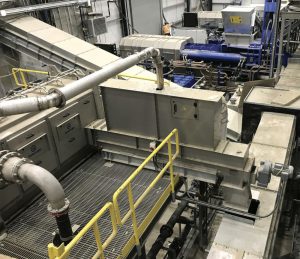
The Dufferin plant has capacity to handle 60,600 tons/year of source separated residential organics. Incoming materials are preprocessed (above) and the resulting slurry is fed into a
wet AD tank. Photo courtesy City of Toronto
Utility Partnership
The RNG, upgraded to 98 percent methane content from about 60 percent in the original biogas, will be injected into the CNG distribution pipeline, owned and operated by Enbridge Gas Distribution Inc. Collection trucks can fuel up at the three City waste collection yards throughout Toronto, which is home to nearly 3 million people.
Under an agreement with Enbridge, “the distribution network has storage capacity that the City can leverage,” says Khan. The City retains ownership of the injected RNG molecules and can use the RNG as it sees fit. The City will be able to withdraw as much RNG as it puts in the grid. It will, however, be required to pay Enbridge for the clean up and injection, distribution and other services provided.
The project supports Toronto’s move toward a circular economy by taking a closed loop approach, where organics collection trucks can ultimately be powered by the waste product they collect, he adds. “RNG generated from food waste is actually considered carbon negative, because the reduction in emissions by not extracting and burning petroleum-based fuel, and the emissions avoided by not sending organics to landfill, exceed the direct emissions associated with the production and use of CNG or diesel.” Compared with diesel, this project has the potential to reduce carbon dioxide emissions by nearly 8,000 metric tons/year, helping Toronto to reach its goal of reducing GHG emissions by 80 percent by 2050.
For Enbridge, the project will help achieve an “aspirational goal” of displacing at least two percent of the fossil natural gas in its pipeline system with RNG, explains Robert Dysiewicz, the utility’s manager of low carbon solutions. Enbridge, and all other gas utilities in North America, “recognize it as an opportunity to contribute to the environmental story,” he notes, adding that Enbridge “is a long way” from the two percent target, in Ontario. “RNG is an emerging resource (and) we would need a lot more like Toronto” to get to the target, he adds.
The City of Hamilton’s wastewater treatment plant is now the province’s only large-scale producer of RNG. But several other projects are under consideration, in addition to Toronto’s projects, and “over the next five years, production numbers for RNG will go significantly higher,” says Dysiewicz.
The technology to upgrade the biogas to RNG quality is from Montréal-based Xebec Adsorption Inc. Xebec will operate and maintain its Pressure Swing Adsorption (PSA) part of the system. Enbridge is providing, and will operate, the equipment to inject the RNG into its pipeline grid. The Xebec system incorporates nine column-shaped vessels containing adsorbent beads. As the biogas flows under pressure up from the bottom, the beads adsorb selectively unwanted carbon dioxide, nitrogen, oxygen, moisture and other impurities from the methane.
When the beads are saturated with impurities, the column is taken off-line to be regenerated by lowering the pressure and flushing the impurities. Each cycle of production and regeneration takes two to four minutes, although the timing can be adjusted. The system automatically analyzes the biogas content, then, adjusts the timing through a rotating valve mechanism at the base of each column.
Shifting Policy Landscape
Ontario’s RNG industry is developing amidst uncertainty in policies and incentives. When the Dufferin project began, Ontario was participating in a carbon trading market with California and several other U.S. states as well as the Province of Québec. Ontario created a Municipal Greenhouse Gas Challenge Fund that would distribute some revenue from the carbon market to projects that would reduce GHG emissions and promote transition to a lower carbon economy. The Toronto RNG project was to receive $10 million from that fund. After last year’s change from a Liberal to a Conservative government, Ontario pulled out of the carbon market and terminated the Challenge Fund. However, the project “was not contingent upon provincial funding and will proceed as scheduled,” Khan says.
On the other hand, the government has indicated it will continue the previous administration’s plan to reduce the amount of organic materials going into landfills and to promote development of RNG. Precise policies are still under consideration but RNG appears to fit within the government’s preference for “environmental solutions that are made in Ontario and make sense,” explains Dysiewicz, at Enbridge.
Toronto began residential curbside collection of source separated organics in 2002. The program now extends to all single–family homes and townhouses in the city, some small businesses, and a portion of the multi-residential buildings, currently about 60 percent, which have wastes collected by the City rather than private contractors. Those sources now total about 176,400 tons of SSO annually.
The Dufferin site can handle 60,600 tons/year, and Disco Road, 82,700 tons. The remainder goes to a privately operated composting facility. The City estimates that if the two digester sites and both landfills were upgrading their biogas and landfill gas they could produce about 64 million cubic meters/year of RNG. Disco Road, with a potential RNG production of 5.3 million cubic meters annually, is scheduled to be next in line. The City will soon issue a request for proposals and complete a feasibility study. Production is “three to four years out,” Khan notes.
The landfill sites are more challenging since the gas generated contains relatively low levels of methane and, potentially, more impurities. Green Lane is estimated to have potential RNG production of 34.1 million cubic meters/year at its final capacity. Since it is active, gas production will continue well into the future, he adds. Still, it’s “some years off.” Based on 2016 estimates, Keele Valley has a potential annual output of 21.2 million cubic metres, but “it may not make sense” to upgrade there as the methane content is low and on the decline and the gas quality is not high. The City hasn’t decided what to do with the RNG these sources would produce, but is fully evaluating all its options this year, Khan explains.
Peter Gorrie is a Contributing Editor to BioCycle.


